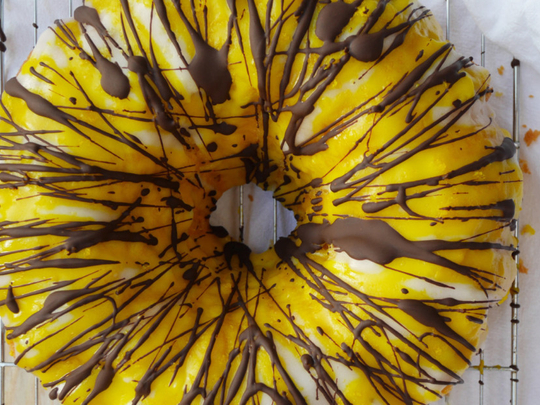
I’m often asked when and where I learnt to cook. The answer is simple; I would spend hours in the kitchen ‘assisting’ my mum and grandma. My gran had shelves stacked full of cooking books, I would spend hours poring over the recipes — the food photography was of course a far cry from the insta-food culture we have today, and many of the recipes were illustrated or shot in black and white photography.
One cookbook I loved was by Marguerite Patten. Like me, she started cooking at an early age; while her mother worked as a teacher she would prepare family meals. During the war, she worked alongside the ministry of food, creating healthy recipes while food rationing was in place. She also broadcast her recipes on BBC radio, making her one of the earliest ‘celebrity chefs’. Her Everyday Cook Book in Colour sold more than a million copies and set a new trend of full-colour cookbooks.
My grandma could see how much I loved the book. One day, I was handed the cookbook and was told to take care of it, to never give it away, and to try and make as many recipes as I could — a promise I have kept to this day.
A recipe I have made over and over again is Marguerite’s Victoria Sponge cake. From the illustration it was tricky to figure out what the cake should look like. Over 30 years later I still use the same recipes, though I’ve altered the methods a little to make a chocolate sponge, or I’ve added candied fruits or chocolate drops.
TV shows like the Great British Bake Off have reinvigorated interest in baking and made ‘celebrities’ of the winners. I’m often asked why I haven’t applied for the show. To be honest, I haven’t watched many of the episodes; now in its ninth series, it has become one of the top UK television shows. Unless the show comes to the UAE, I don’t think I have a chance.
Baking is a science, and over the years I have had some disasters. However, this tried-and-tested recipe courtesy of Mrs Patten has always been a winner. It works for all kinds of cakes, from fairy to Bundt ones. The Bundt shape was inspired by a European cake known as Gugelhupf — the style of mould was popularised in the 1950s and 1960s when cookware manufacturer Nordic Ware trademarked the name “Bundt” and began producing the tins from cast aluminium. You can find the tins in most home stores or online. The non-stick version is the best as the cake can be tricky to remove from the tin.
I’ve used all kinds of decorations — at Christmas I added melted plain chocolate and pomegranate seeds. It’s perfect for birthday celebrations and a popular request from my colleagues. By far, lemon drizzle is the most popular version and the most requested. I’m sure Marguerite wouldn’t mind the slight alterations I’ve made to her recipe, her book is still in safe hands, and if the Great UAE Bake Off happens, I will consider an application.
Iced lemon drizzle bundt cake
Serves 8-10, prep time 10 minutes, cooking time 1 hour
Ingredients
■ 340g caster sugar
■ 6 free-range eggs
■ 340g butter
■ 340g self-raising flour
■ 1/2 tsp baking powder
■ Zest of a lemon
■ 25cm Bundt cake tin
For decoration
■ 8 tbsp of icing sugar
■ Juice and zest of a lemon
■ 1 tsp of yellow food colouring
■ 4 squares of 70% cocoa plain chocolate
Method
Preheat the oven to 180 degrees. Cream the sugar, eggs and butter in a food processor for five minutes. Sift the flour and baking powder into a bowl, and add to the egg mixture along with the lemon zest. Mix for a further five minutes.
Meanwhile, grease the Bundt cake tin. Pour the cake mixture into the tin so that it’s evenly spread, and place in the oven.
While the cake is cooking, prepare the first layer of icing: sift 4 tbsp of the icing sugar into a bowl, add a few drops of lemon juice and mix well. Keep adding lemon juice until the icing is smooth in texture (keep a little juice aside for the next batch of icing). After 45-50 minutes, check the cake is cooked by pushing a sharp knife into the sponge — if the blade is clean, it’s done. Remove the cake from the oven and allow to stand for five minutes before turning out onto a wire rack, then allow to cool thoroughly.
For the decoration: Drizzle the icing from the outside into the centre of the cake, then sprinkle with lemon zest. Allow to sit while you prepare the yellow icing: add the remainder of the icing sugar to a bowl with the yellow food colouring, mix to a paste, add the remaining drops of lemon juice until the mixture is smooth. Repeat the icing process, spooning from outside to the centre. Leave to set while you melt the chocolate.
Place a small pan with a little water over heat and bring to the boil. Break the chocolate squares into a small glass bowl and place over the pan, making sure that the bowl does not touch the water. When the chocolate has melted, remove from the heat and let stand for a few minutes. Using the same technique, drizzle the sponge with the chocolate. Leave to set then serve.
— Recipes, food styling and photography by Mark Setchfield, follow him on Instagram @gasmarksix









